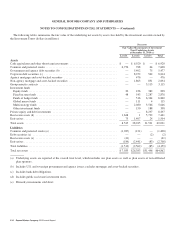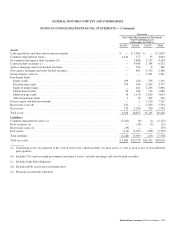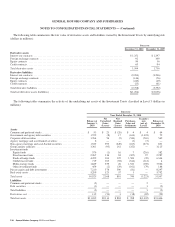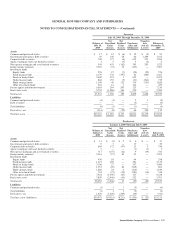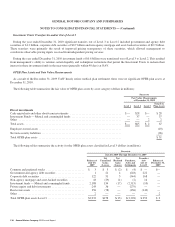General Motors 2010 Annual Report Download - page 221
Download and view the complete annual report
Please find page 221 of the 2010 General Motors annual report below. You can navigate through the pages in the report by either clicking on the pages listed below, or by using the keyword search tool below to find specific information within the annual report.
GENERAL MOTORS COMPANY AND SUBSIDIARIES
NOTES TO CONSOLIDATED FINANCIAL STATEMENTS — (Continued)
Predecessor
January 1, 2009 Through July 9, 2009
Balance at
January 1,
2009
Net
Unrealized
Gains
(Losses)
Net
Realized
Gains
(Losses)
Purchases,
Sales and
Settlements
Transfers
into
(out of)
Level 3
Balance at
July 9,
2009
Common and preferred stocks ............................. $ — $ (5) $ — $ 8 $ — $ 3
Government and agency debt securities ...................... — — — — 1 1
Corporate debt securities ................................. 89 26 (5) 12 — 122
Non-agency mortgage and asset-backed securities ............. 24 — (1) (5) — 18
Investment funds — Mutual and commingled funds ............ 2,403 333 (104) (272) (172) 2,188
Private equity and debt investments ......................... 245 17 (16) (3) — 243
Real estate assets ....................................... 415 (71) 1 11 — 356
Other ................................................. 2 — — — — 2
Total OPEB plan assets Level 3 ............................ $3,178 $300 $(125) $(249) $(171) $2,933
Significant Concentrations of Risk
The pension plans’ Investment Trusts include investments in certain investment funds, equity, debt and real estate investments and
derivative instruments. Some or all of these investments may be illiquid. The investment managers may be unable to quickly liquidate
some or all of these investments at an amount close or equal to fair value in order to meet a plan’s liquidity requirements or to respond
to specific events such as deterioration in the creditworthiness of any particular issuer or counterparty.
Illiquid investments held in the Investment Trusts are generally long-term investments that complement the long-term nature of
pension obligations and are not used to fund benefit payments when currently due. Plan management monitors liquidity risk on an
ongoing basis and has procedures in place that are designed to maintain flexibility in addressing plan-specific, broader industry and
market liquidity events.
Certain assets held by the Investment Trusts represent investments in group annuity contracts. We entered into group annuity
contracts with various life insurance companies to provide pension benefits to certain of our salaried workforce and backed these
obligations by high quality fixed income securities. We, as the plans’ sponsor, might be exposed to counterparty risk if any or all of
the life insurance companies fail to perform in accordance with the terms and conditions stipulated in the contracts, or any or all of the
life insurance companies become insolvent or experience other forms of financial distress. We and the plans might also be exposed to
liquidity risk due to the funding obligation that may arise under these contracts. The plans’ management monitors counterparty and
liquidity risks on an on-going basis and has procedures in place that are designed to monitor the financial performance of the life
insurance companies that are parties to these contracts and maintain flexibility in addressing contract-specific and broader market
events.
The pension plans’ Investment Trusts may contain financial instruments denominated in foreign currencies. Consequently, the
plans might be exposed to risks that the foreign currency exchange rates might change in a manner that has an adverse effect on the
value of the Investment Trusts’ foreign currency denominated assets or liabilities. The Investment Trusts use forward currency
contracts to manage foreign currency risk.
The pension plans’ Investment Trusts may invest in fixed income securities for which any change in the relevant interest rates for
particular securities might result in an investment manager being unable to secure similar returns upon the maturity or the sale of
securities. In addition, changes to prevailing interest rates or changes in expectations of future interest rates might result in an increase
or decrease in the fair value of the securities held. The plans’ Investment Trusts may use interest rate swaps and other financial
derivative instruments to manage interest rate risk.
Counterparty credit risk is the risk that a counterparty to a financial instrument held by the Investment Trusts will default on its
commitment. Counterparty risk is primarily related to over-the-counter derivative instruments used to manage risk exposures related
General Motors Company 2010 Annual Report 219







